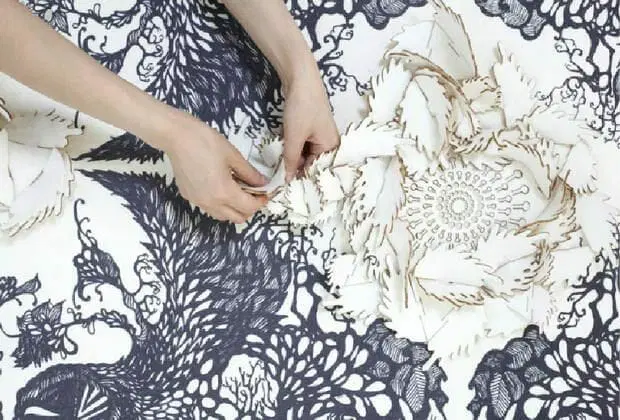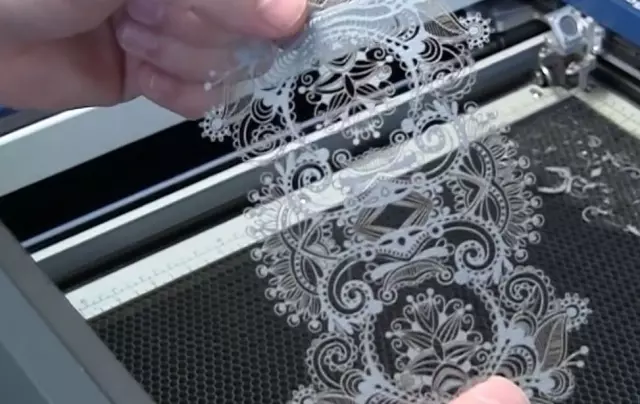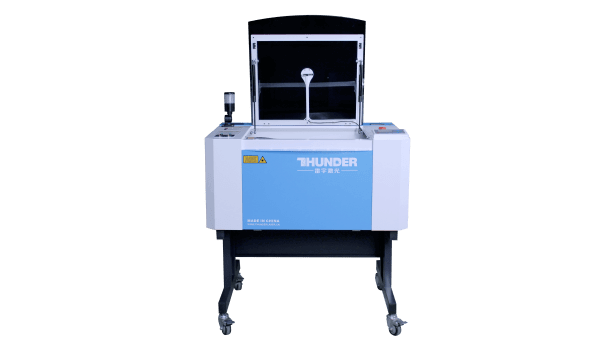Laser Cutting for Textiles and Clothing
Since the 19th century, laser cutters have been used by the garment industry to improve productivity, speed and accuracy. From achieving clean-cut edges to preserving the quality of fabrics, there’s no shortage of benefits when it comes to laser cutting textiles.
In the past, laser technology came at a high price and was thus reserved for big brands that could afford the equipment. Over time, laser machines have become more portable, accessible and affordable — now any small business can reap the unique benefits offered by laser processing. Here’s a closer look at the function of laser cutting machines and how they’ve revolutionized the clothing industry.
How Laser Cutting Works
If you’ve never used a laser cutting machine before, you may be wondering how it works. A classic laser cutter is a computer numerical controlled (CNC) machine that operates electronically. It features a laser head with an autofocus lens that moves over your material (such as the fabric surface) and pinpoints the exact location to begin the cut. Most laser cutters use one of two lasers:
- C02 laser: A speedy, smooth laser designed for non-metal elements (such as for laser cutting textiles and plastic)
- Fiber laser: A strong, durable laser designed for metallic materials (such as for laser cutting stainless steel)

In addition to cutting, laser cutters are often used to engrave materials. During the laser engraving process, a laser beam is set at high heat to vaporize material — this physically removes some of the substance, ultimately creating a visibly noticeable impression. The minimum depth required for laser engraving is 0.005 inches, although the process may be repeated to achieve deeper marks. Laser engraving is often used to make serial numbers, logos and customized designs.
Cutting and engraving using a laser cutting machine allows for higher accuracy, increased speed and elevated productivity. Not only are laser machines incredibly precise, but they can also get the job done in a matter of seconds. These elements make laser systems a valuable tool in textile processing.
Are Laser Cutters Safe?
A major concern with laser cutting is safety — these machines tend to use high levels of heat, which can be dangerous to work with. The good news is, the laser cutting process is perfectly safe as long as you follow the recommended safety guidelines. These include:
- Supervising the machine at all times
- Keeping the area around the machine clean
- Working with approved materials
- Keeping a fire extinguisher in the vicinity
- Not disabling any safety features
Many laser cutting machines also come equipped with alarm lamps to alert you of an emergency and exhaust systems to prevent overheating.
Laser Cutting in the Textile Industry
From material processing to design creation, laser cutting can be used at virtually every stage in the garment industry. Here are some of the main benefits of laser cutting fabrics and textiles.
Improved Accuracy
Every year, over 13 million tons of textile waste is produced on a global basis. While some of this waste is a result of consumers getting rid of old clothes, a solid portion comes from fashion companies throwing out unusable clothing. One of the best ways to prevent waste and ensure all materials are being used is by laser cutting clothing.
Because laser cutters use electronic CNC machines, they’re able to determine the exact location of a cut and execute it smoothly. The standard laser system has a high precision level of about ± 0.0005 inch. Sheet metal and manual cutting methods, on the other hand, lack this technology and are thus more prone to mistakes. By consistently making accurate cuts, you can reduce manufacturing mistakes and create uniform, high-quality products that boost your brand reputation.

Higher-Quality Clothing
More and more people are searching for high-quality clothing that’s also affordable. By using laser technology, small brands can produce upscale clothing without having to shell out for higher-priced fabrics. Laser power enhances clothing in a number of ways, including:- Making cleaner cuts
- Reducing fraying and lint
- Achieving contours
Fabrics that are prone to fraying, such as nylon and Dacron fabric, may be reinforced through sealed edges. In this case, the edges of the fabric are physically sealed together using the heat of a laser beam, resulting in sturdier fabric that’s less likely to unravel.
Finally, laser cutting technology allows for more unique, contoured clothing. By achieving incredibly fine, precise cuts, laser cutting can create garments that are shaped for specific sizes.
Versatility
Being able to adapt is key to surviving and thriving in the textile and clothing industry. One of the main benefits of laser cutting machines is that they can work with a wide range of materials, letting you adapt to popular and changing trends. These materials include but are not limited to:
- Synthetic fabrics
- Nylon
- Polyester
- Cotton
- Lace
- Denim
- Leather
- Artificial fur
Cutting these materials requires the use of a standard CO2 laser. By experimenting with different types of garments, you can expand your product line and even attract new customers.
Increased Speed
Anybody who has worked in manufacturing knows the importance of speed — the faster you move, the more products you can create. Not only does a higher quantity of garments help reduce the risk of low inventory, but it also lets you expand your product range. Laser cutting technology allows you to boost your speed without sacrificing quality — the average laser cutting machine can cut approximately 8 meters of material in just a minute. A higher-powered machine can work even faster. For instance, a 1000 watt machine can achieve rates of up to 17 meters per minute.
One thing that makes laser cutters unique is that they can boost your productivity without requiring extra employees. However, the machine should always be supervised by at least one operator for safety reasons.
Cost-Efficiency
The average cost of starting a clothing company can range anywhere from $1,500 for a medium-sized business to over $50,000 for a large business. A big portion of this budget is reserved for material and labor costs, both of which can be reduced through laser cutting. Laser technology helps save money by:
- Reducing the amount of wasted material
- Preventing material from being tainted
- Increasing output
- Decreasing labor costs
Imprecise cuts lead to a higher amount of material scraps, which translates to fabrics that you pay for but aren’t using. Thanks to the increased accuracy of laser machines, you can achieve accurate cuts that help ensure you’re getting as much mileage as possible out of your materials.
Another benefit of using a laser cutting machine is that it’s a no-contact process — no human needs to physically handle the material. This prevents the formation of unsightly marks that would otherwise taint the fabric and decrease its value.
Finally, because of their speed, laser cutting machines can increase your efficiency and let you create more products in a shorter time frame. This higher productivity, when combined with decreased labor costs, helps you increase your inventory at a lower price point. These saved costs make it easier to lower your prices, which can help you connect with more consumers.
Unique Products
One of the best ways to make your brand stand out is by creating unique, custom products that can’t be found elsewhere. Laser engraving uses heat to create small impressions that can be manipulated into unique designs and graphics. Ideas for engraving textiles include:
- Logos
- Phrases
- Images
- Customizable products

If you want to create an identifiable brand, consider making a logo for people to associate with your name. Laser cutting machines let you craft consistent and uniform logos you can imprint onto multiple products. Alternatively, you might want to diversify your products by decorating them with an assortment of different words or images.
Another fun idea that can be achieved through laser engraving is a customizable product line. You can cater to your customers’ wishes by letting them request names, slogans or even graphics for you to engrave onto an article of clothing.
What Type of Laser Do I Need For Textile Laser Cutting?
Now that you understand the benefits laser cutting brings to the textile and clothing industry, it’s time to find a laser cutter that can meet your needs. At Thunder Laser USA, we offer an assortment of affordable, high-quality laser machines that can enhance your productivity and efficiency. Here are some of the machines we recommend for your project.
Nova 63: Best for Experienced Laser Cutters
The Nova 63 is our flagship model. It has a 63-inch bed size and comes in both 100- and 130-watt configurations. This machine is perfect for your standard-sized garment project and can work with several fabrics, from polyester to cotton. Because of its power level, this machine is best for those who have some experience with laser cutting.
Nova 24: Best for Beginners
The Nova 24 has a 60-watt tube and a 24-inch bed size. It can be used to accurately cut, mark and engrave a wide variety of materials, which makes it perfect for the garment industry. This machine comes at a lower power level than most of our other machines, which makes it ideal for those who are new to laser cutting.
Odin 22: Best for Speedy Engraving
If you’re looking for a high-quality laser engraving machine, the Odin 22 is for you. With an engraving speed of 2000 millimeters per second, the Odin 22 can help you increase your output and complete your projects at a fast rate. It’s also capable of highly detailed engraving. Keep in mind that this machine is intended for those with minimal cutting needs.
Nova 51: Best for Big Garment Projects
With a work area of 51.2 x 35.4 inches, the Nova 51 is the best option for anyone with larger projects. The machine itself has a bed size of 51 inches, comes in watt configurations of 100 and 130 and can fit a sheet of 4′ x 8′ material using a pass-through.
Nova 35: Best for Textile Engraving
The Nova 35 is one of our most popular machines. It’s available in both 80- and 100-watt configurations and comes with a bed size of 35 inches. As a laser engraving machine, it’s best for those who want to diversify their products with custom logos and images. However, it’s also capable of cutting and has a cutting area of 35 inches.
Mini 60: Best for Those With Limited Space
With a 40-watt bulb and 24-inch bed size, the Mini 60 is one of the smallest laser machines in our portfolio. However, don’t let its size fool you — this machine is capable of cutting, engraving and marking a wide range of materials, including different fabrics and textiles. Its compact size makes it the perfect machine for beginners and people with limited space.
Thunder Laser USA: Start Your Garment Project Today
If you want to create high-quality products for your customers, you’ll need to use a high-quality laser cutting machine. Our modern laser machines let you calibrate the intensity of the laser and adjust the depth and thickness, allowing for unprecedented levels of personalization. Each machines comes with unique amenities designed to enhance performance, including:
- Chiller water pump
- Honeycomb/knife beds
- Auto focus/red dot pointer
- Cleaning kits
- Pass-through doors (optional)
We also conduct all our production overseas, which lets us create more affordable machines without compromising on quality. Our dedicated team is on-hand in Texas, USA, to ensure each machine meets our high standards. Contact us today and get started on your new garment project!